Accounting localization: Colombia in Odoo 17
Accounting localization in Odoo 17 refers to the capability of adjusting the accounting module to the laws and customs of particular nations. Packages for fiscal localization are used to accomplish this. By using localization, people from different nations can localize ERP commodities in accordance with national regulations. Since every nation has different tax laws, the localization option makes tax automation easier.
For setting the localization for a company, first, you need to configure a Colombian country. To set a country, go to the Users and Companies menu from the general settings and click the companies sub-menu.
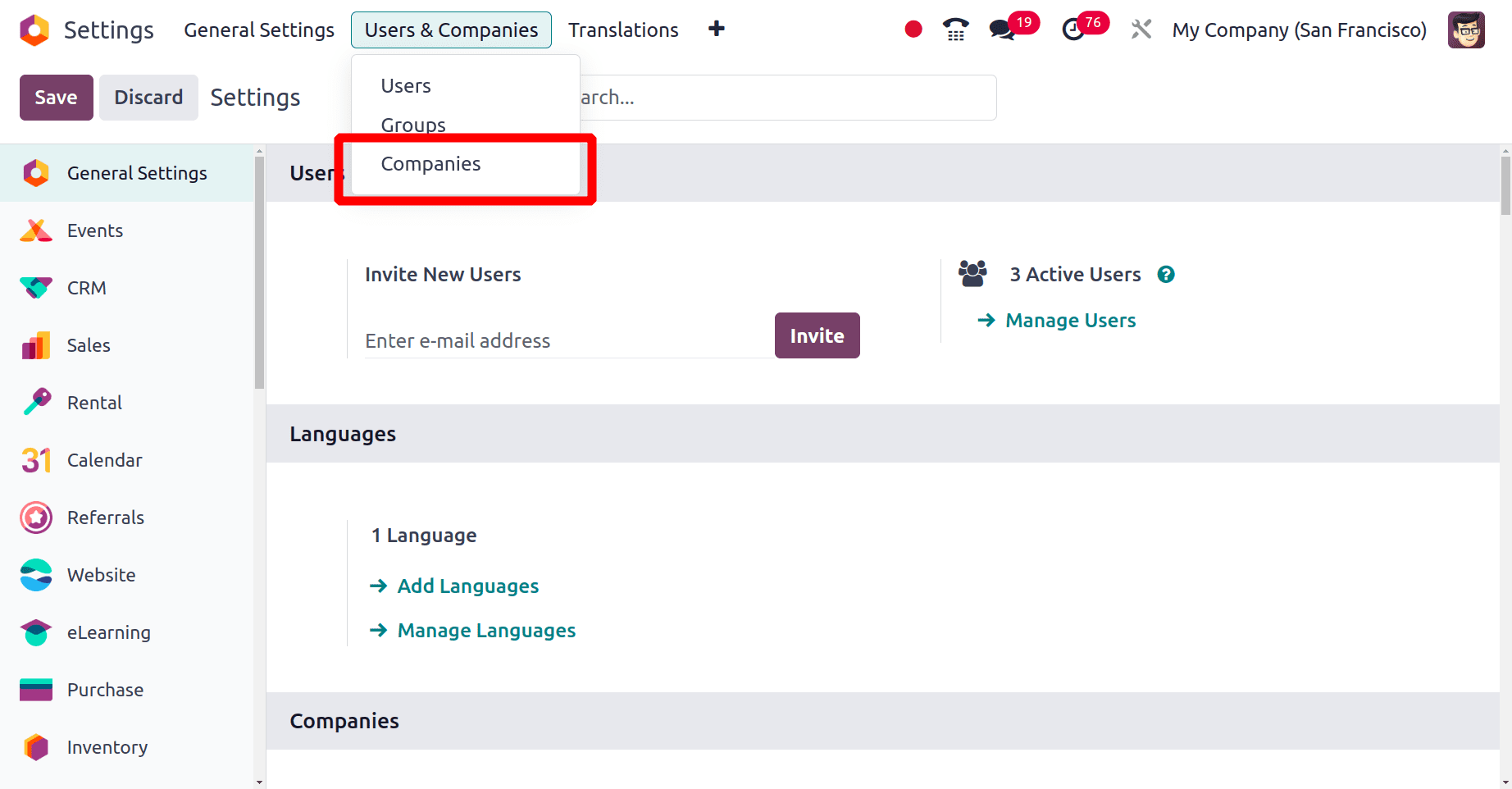
There you get a list of companies and you can also create new companies from the window by clicking on the New button. Then you get a form to fill up the details for the company. Provide the company name, address of the company, and country to which the company belongs. Along with these details, you can provide more details about the company on this page itself. Here in this form, when we set the country as Colombia, the currency in Colombia is the Colombian peso (COP) automatically configured to the form. After filling those details, save the form, and thus, the company has been created successfully.
The next step is to set the localization for the company. For that, navigate the Configuration settings of the Accounting application. In configuration settings, under the fiscal localization section, set the specific localization for the Colombian country under the package field, and click the save button to save the package.
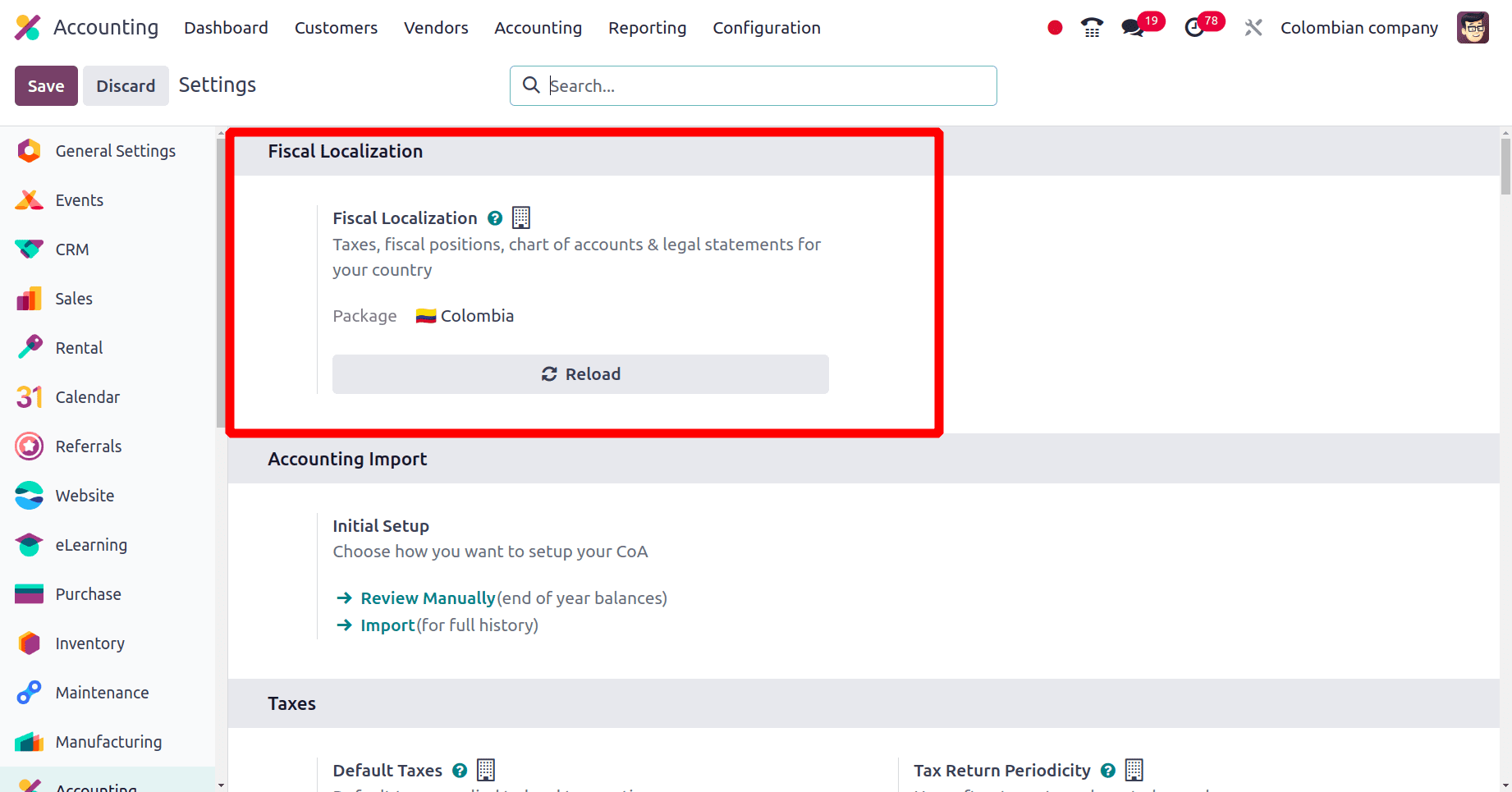
This feature assures adherence to regional tax laws and accounting standards. Odoo 17 localization modules frequently include pre-configured versions of the essential tax laws, reports, and charts of accounts that are necessary for your nation. When compared to manually configuring your accounting system, this can save you both money and time.
Changes emerged when Colombian accounting localization was set up in Odoo 17
You can set the default tax of your company in the Configuration settings of the Accounting application. The pre-selected tax that will be applied automatically to sales or purchase transactions for a certain firm is known as the default tax of that company in Odoo 17. In the majority of situations, it guarantees consistency and saves time. When you set the package for the company, Odoo automatically sets the default tax for the company, which is used all over the country under the default tax section in the Configuration settings.
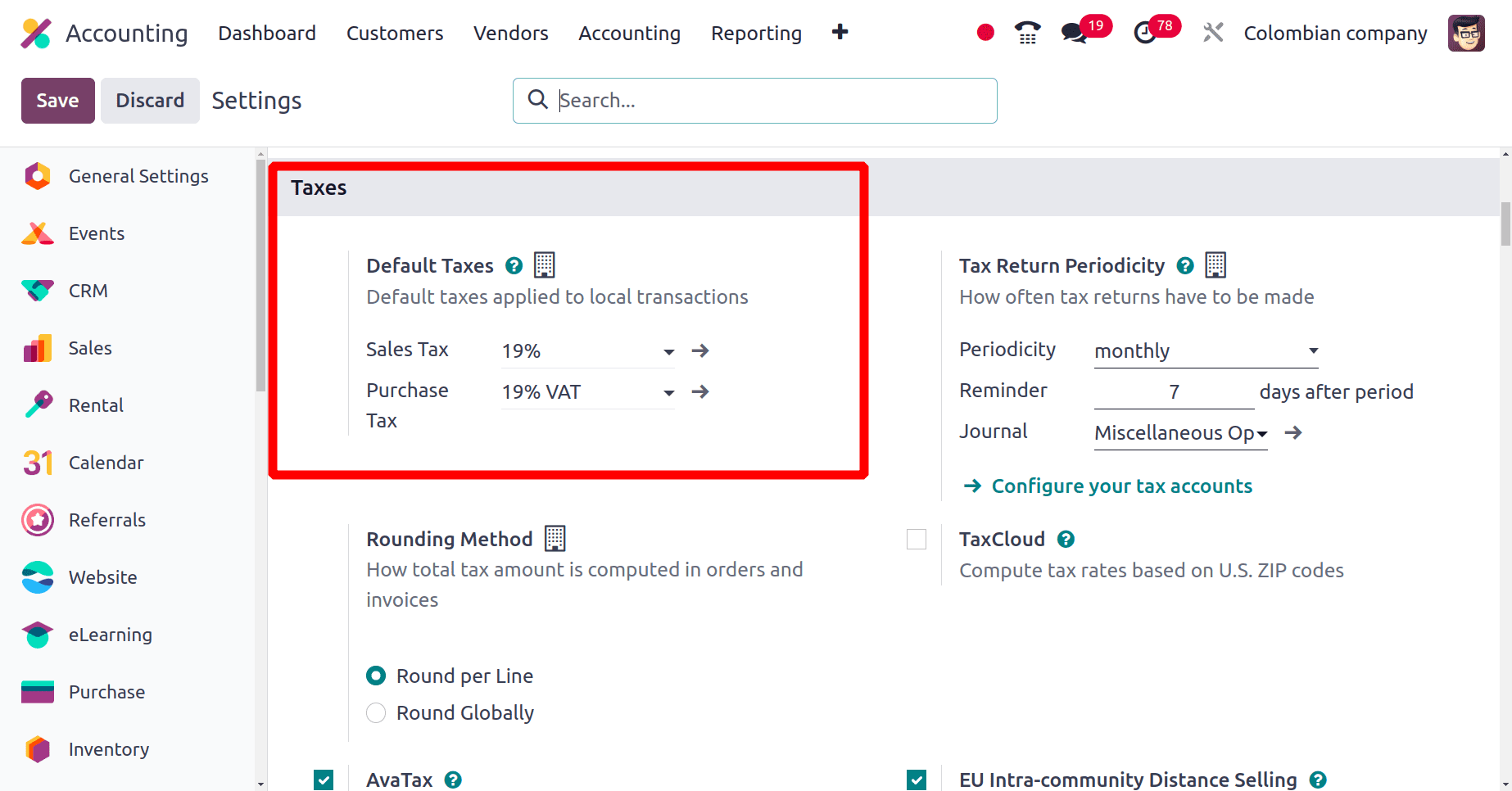
From the screenshot, you can see that the default sales tax is 19% and the default purchase tax is 19% VAT in Colombia.
The next is the Fiscal country of the company. There is a fiscal country field under the tax section in the configuration settings.
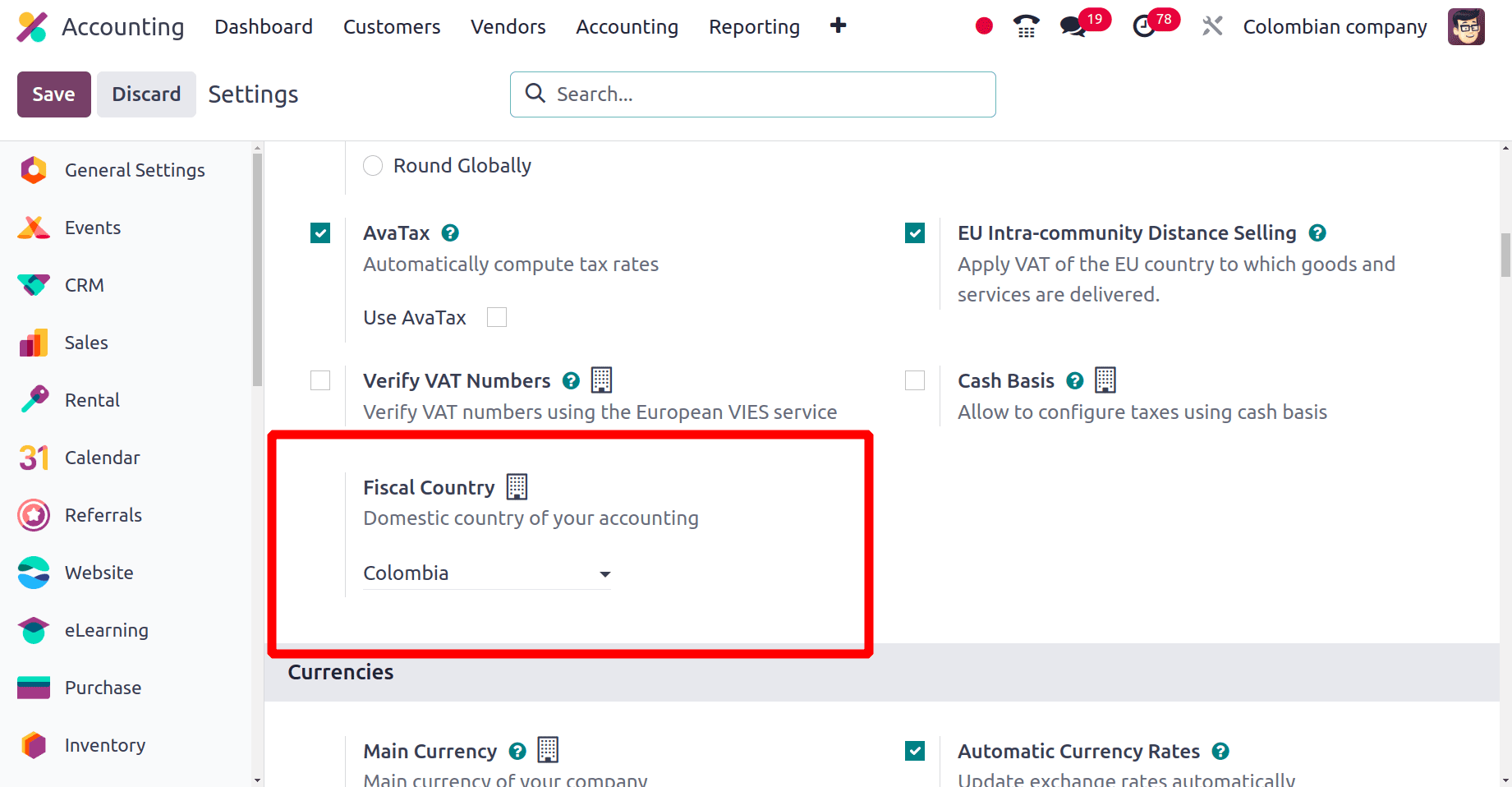
So as you set the specific package for Colombia, Odoo automatically sets the fiscal country as Colombia.
In the configuration settings, under the Currencies section, you can give the main currency that is used by the company. You know that the currency used in Colombia is the Colombian peso (COP). So when you set up the localization package as Colombia, there is no need for you to provide the main currency in Configuration settings. Because Odoo automatically sets the Colombian currency (COP) as the main currency.
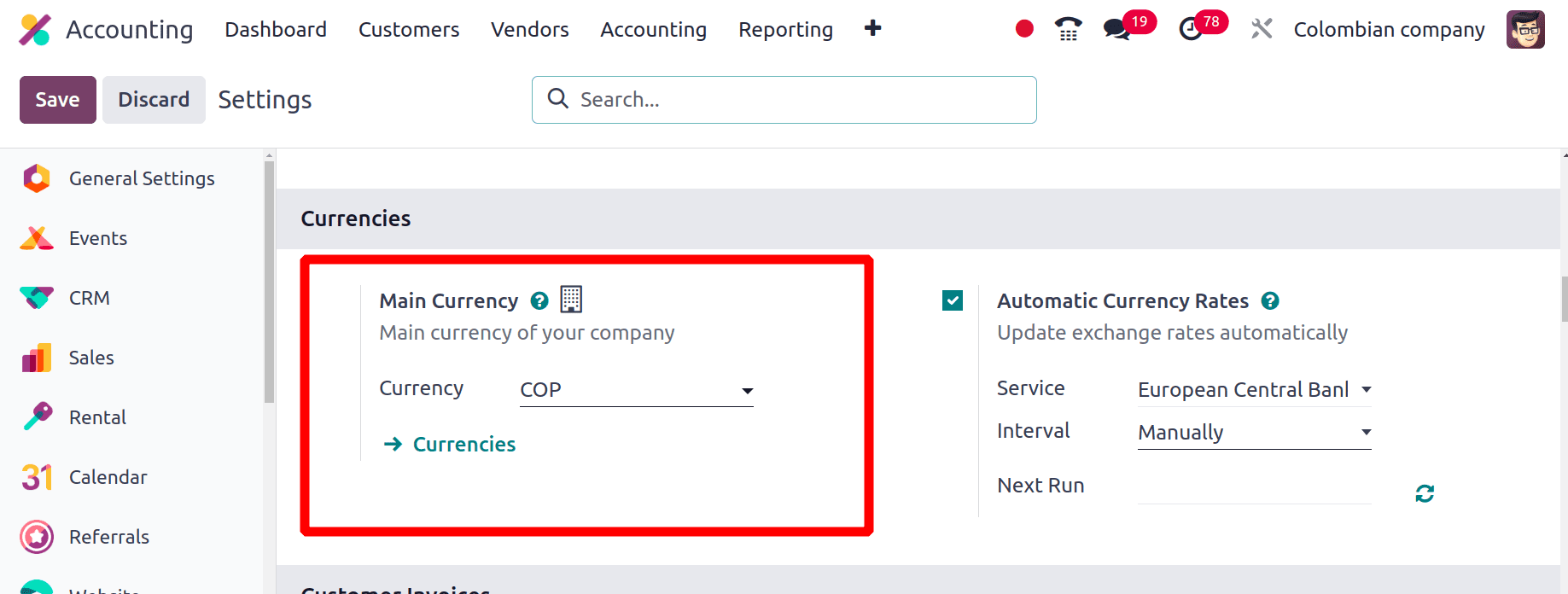
There is an extra section in the Configuration settings, that is ‘Colombian Electronic Invoicing’. It deals with a few crucial elements to guarantee Colombian businesses have effective and compliant invoice management, which guarantees compliance with the e-invoicing laws in the country.
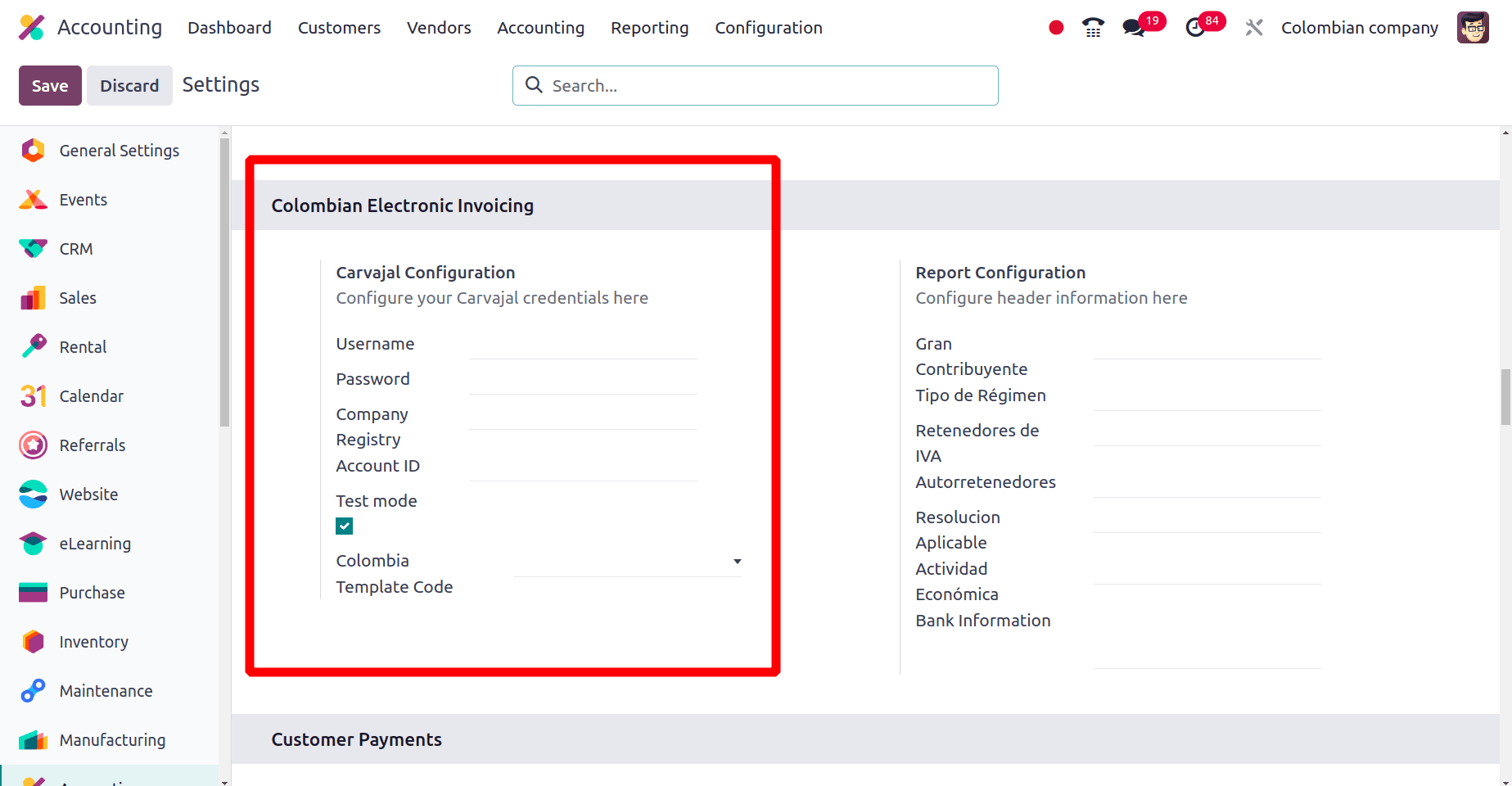
In this section, you can set Carvajal credentials. The login credentials used to link Odoo to Carvajal's electronic invoicing service are referred to as Carvajal credentials. With the use of this service, Colombian businesses can electronically invoice in accordance with DIAN (Dirección de Impuestos y Aduanas Nacionales) laws. Just look at the steps or the workflow for the Electronic invoicing when Colombian localization has been set up for a company,
* The sender generates an invoice.
* The valid XML file is created by the electronic invoice provider.
* The invoice electronic code, or CUFE, is created by the electronic invoice provider using the electronic signature.
* DIAN receives notification from the provider of electronic invoices and DIAN validates the invoice.
* DIAN approves or rejects the invoice.
* The PDF invoice with a QR code is generated by the electronic invoice provider.
* The acquirer receives the invoice from the electronic invoice provider.
* The acquirer either approves or rejects the invoice after sending a receipt of acknowledgment.
* The PDF and XML are downloaded by the sender as a.zip file.
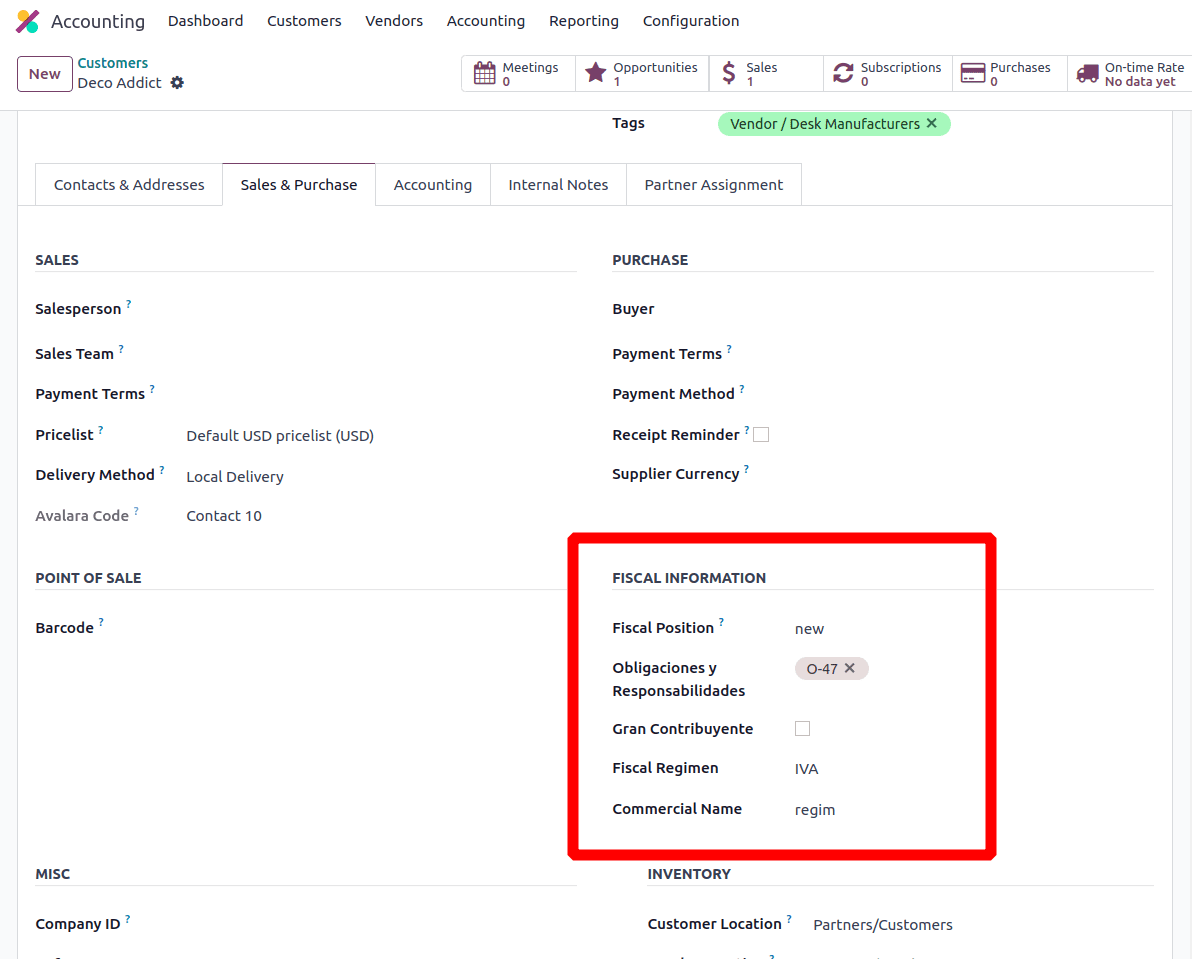
In the sales and purchase tab of the partner form, under the Fiscal Information section, Fiscal Position, Obligaciones y Responsabilidades, Gran Contribuyente, Fiscal Regimen, and Commercial Name want to set.
* In Colombian accounting localization for Odoo, Obligaciones y Responsabilidades (Obligations and Responsibilities) refer to the tax responsibility codes associated with a company. These codes are defined by the Colombian tax authority, DIAN, and identify a company's tax obligations.
* Gran Contribuyente, or "Large Contributor" in English, is the term used to describe a class of taxpayers in Colombia who are thought to have made significant contributions to the country's tax income. Compared to other taxpayer categories, companies categorized as Gran Contribuyente are subject to harder tax laws and filing requirements. This usually entails electronic invoicing and more regular tax submissions.
Then create an invoice for this customer, while creating the invoice you can see that additional fields are added to the invoice form.
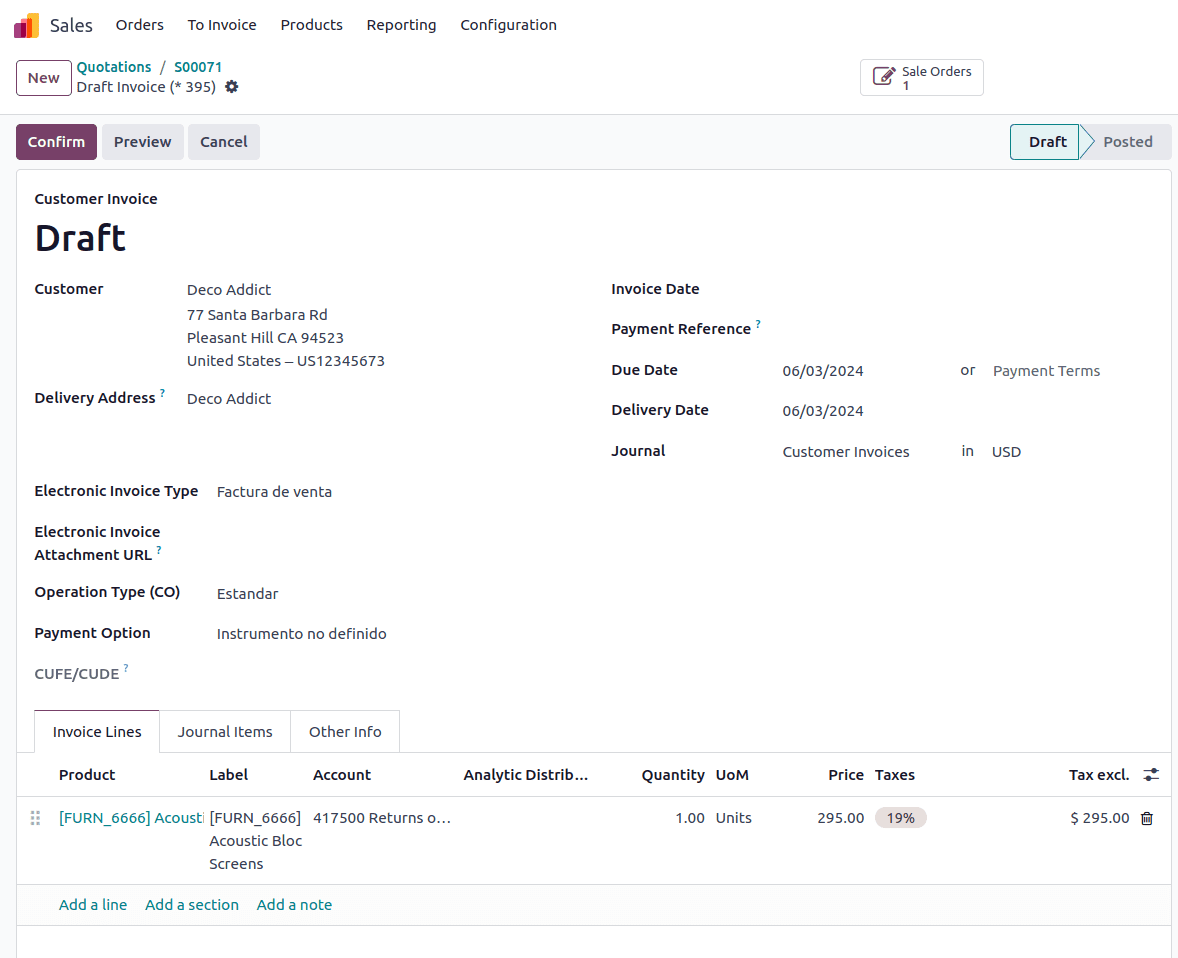
In the customer invoice form, Electronic Invoice Type, Electronic Invoice Attachment URL, Operation Type (CO), Payment Option, etc are added.
* Electronic Invoice Type: The category of the electronic document you are issuing is known as the "Electronic Invoice Type."
* Electronic Invoice Attachment URL: Provide any additional information in URL form here and it will be attached to the invoice.
* Operation Type (CO): This refers to the type of transaction that is recorded in the invoice. It's a field on the invoice form that aids in the invoice's classification for possible tax and accounting uses.
* Payment Option: Describes the payment method the customer will use to pay the invoice amount.
In the sales journal, under the Advanced Settings tab, there is an additional section RESOLUCIÓN DIAN, and under this section set up the Resolución de Facturación, Fecha de Resolución, Fecha de finalización Resolución, Range of numbering (minimum) and Range of numbering (maximum).
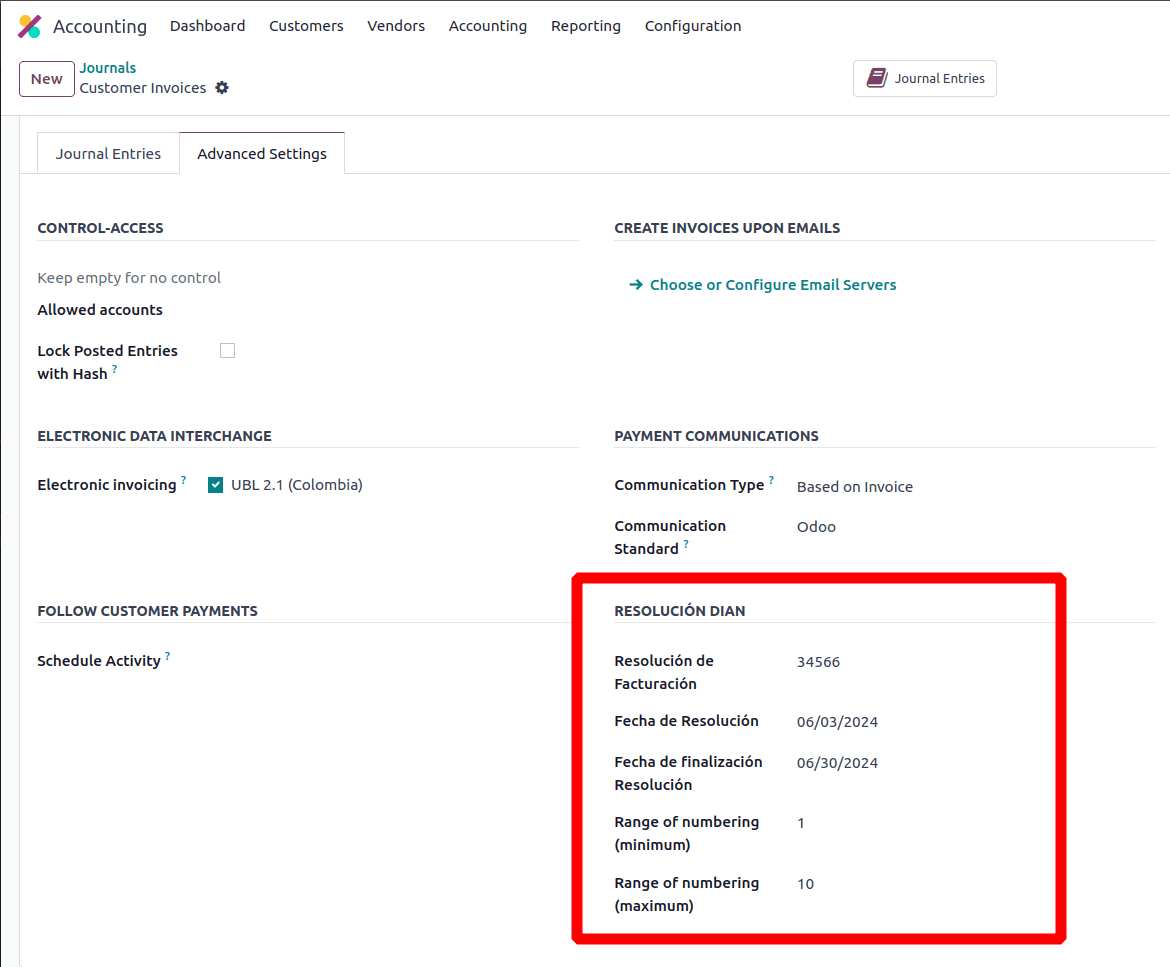
* "Resolución de Facturación" which is "Invoicing Resolution". It refers to the formal document that the Colombian National Directorate of Customs and Taxes (DIAN) issues granting a business permission to send electronic invoices.
* "Fecha de Resolución" (Resolution Date) refers to the day that a resolution from the Colombian tax authorities that may be relevant to the invoice was issued.
* Fecha de finalización Resolución (Resolution expiration date) refers to the day on which a resolution or authorization issued by the Colombian tax authority (DIAN) expires.
* Range of numbering (minimum) is the beginning of an invoice number sequence that is used for electronic invoicing. This arrangement guarantees individual identity for every invoice and aids in the upkeep of accurate accounting records.
* Range of numbering (maximum) refers to a configuration that establishes the upper bound of a sequence used to generate document reference numbers, such as invoice numbers.
After all these details are configured properly, click the confirm button in the above invoice form and click the ‘send and Print’ button to send the invoice to the customer. There we get a pop-up windo which contains all the details of the sending mail.
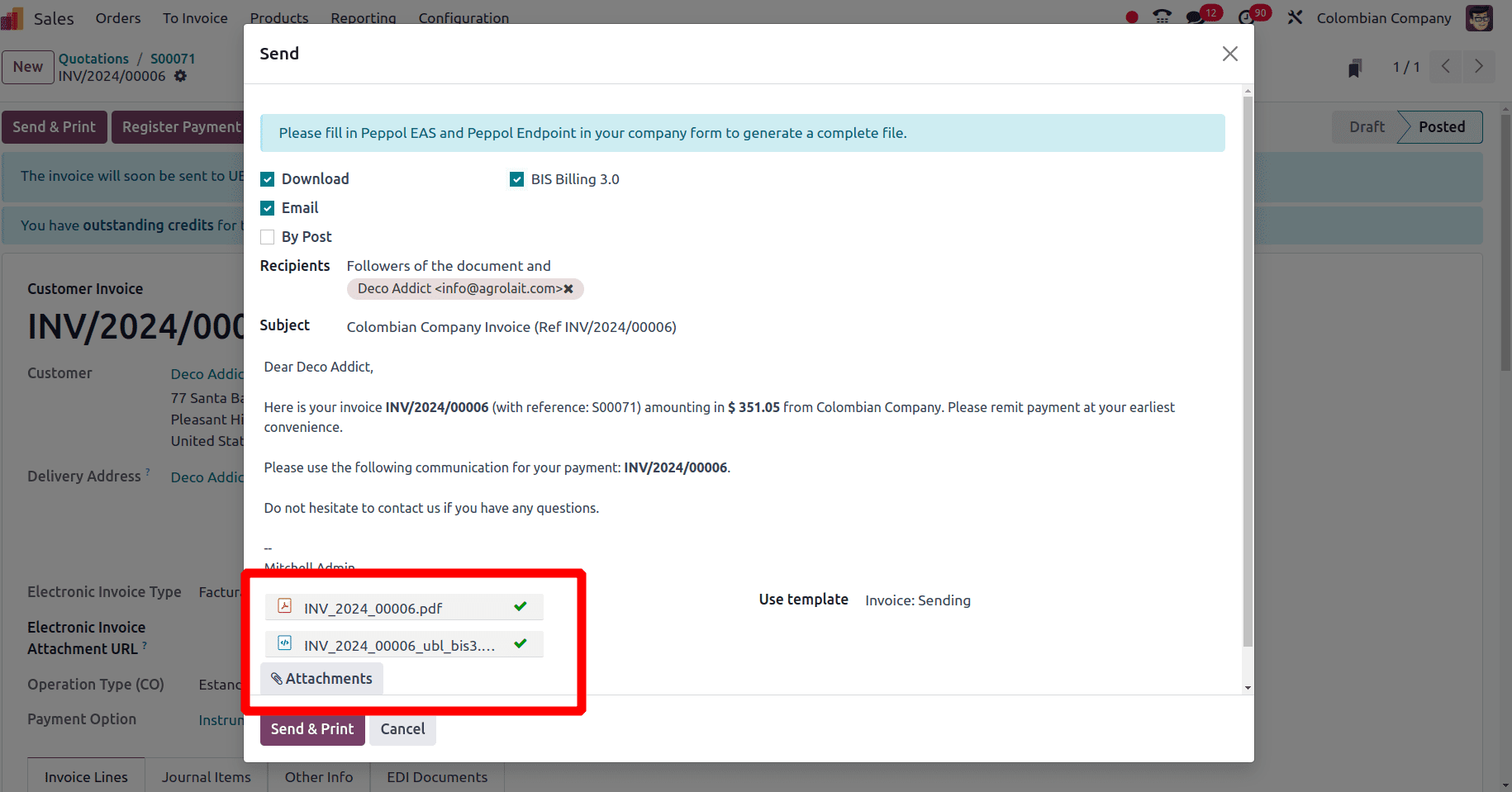
There we can see that both XML file and Pdf files are attached with the invoice which is sending to the customer. Click the send and print button and complete the sale order by completing the payment.
Next, under the Configuration menu, you get a Taxes sub-menu. When you click the Taxes sub-menu you get a list of taxes and from that list of taxes a Colombian company can use any of them for their businesses.
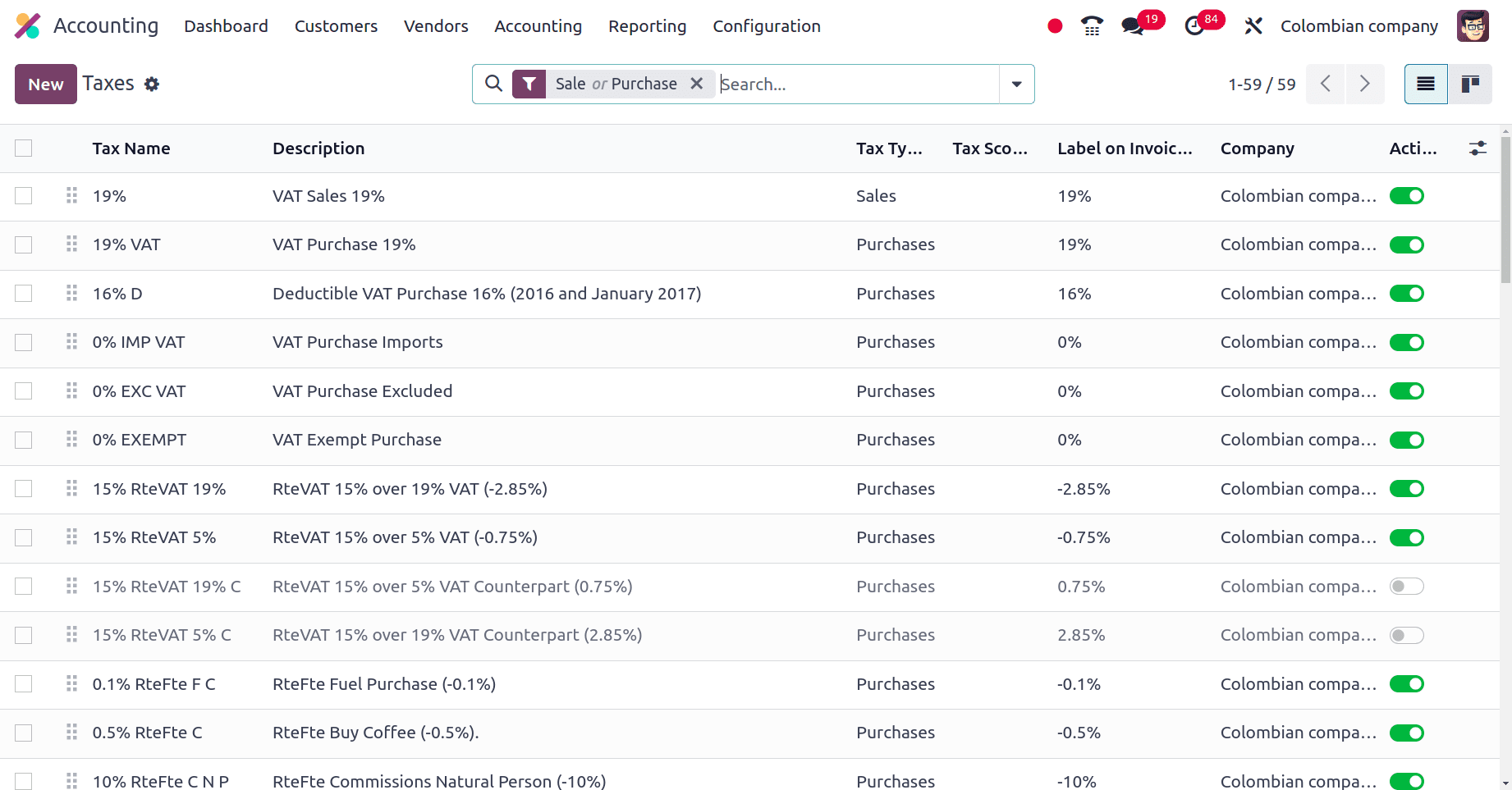
Then you can move to the reporting menu of the accounting application. There are different sub-menus, Balance sheets, Profit and Loss, Cash Flow Statements, Tax reports, etc. Just look at the Balance sheets of the Colombian company. For that, click the Balance sheet sub-menu under the Reporting menu.
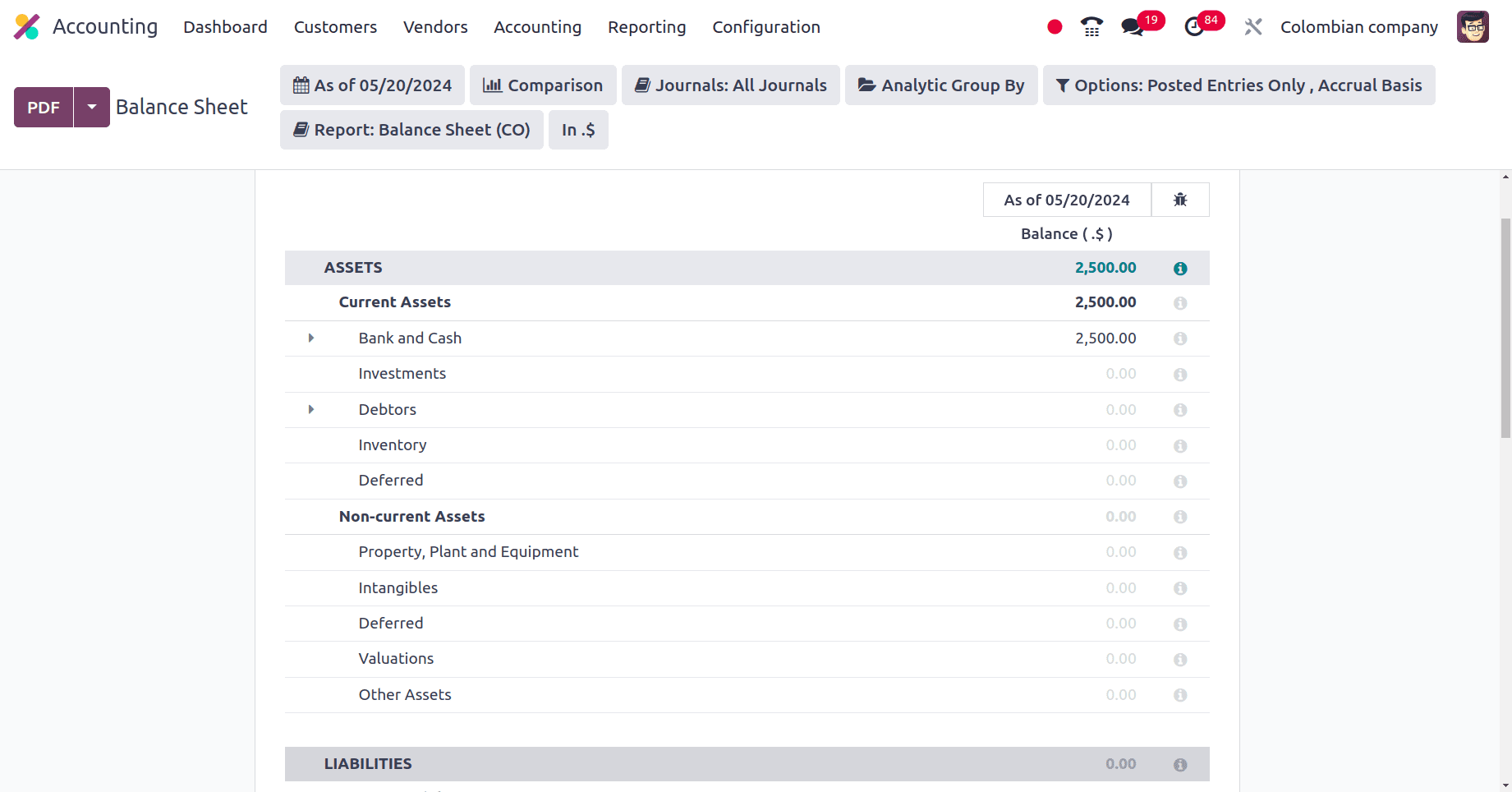
In the Balance sheet, you can see the Assets, Liabilities, and Equity of the company. Current assets and noncurrent assets are included in the Assets list and the current liability and non-current liability are included in the liabilities of the company. Special capital, Capital surplus, reserves, the result of the year, etc are included in the equity list of the Balance sheets.
The next is the profit and loss of the company. Under the Reporting menu, there is a Profit and Loss sub-menu. Choose the profit and loss sub-menu and then a profit and loss list will be shown.
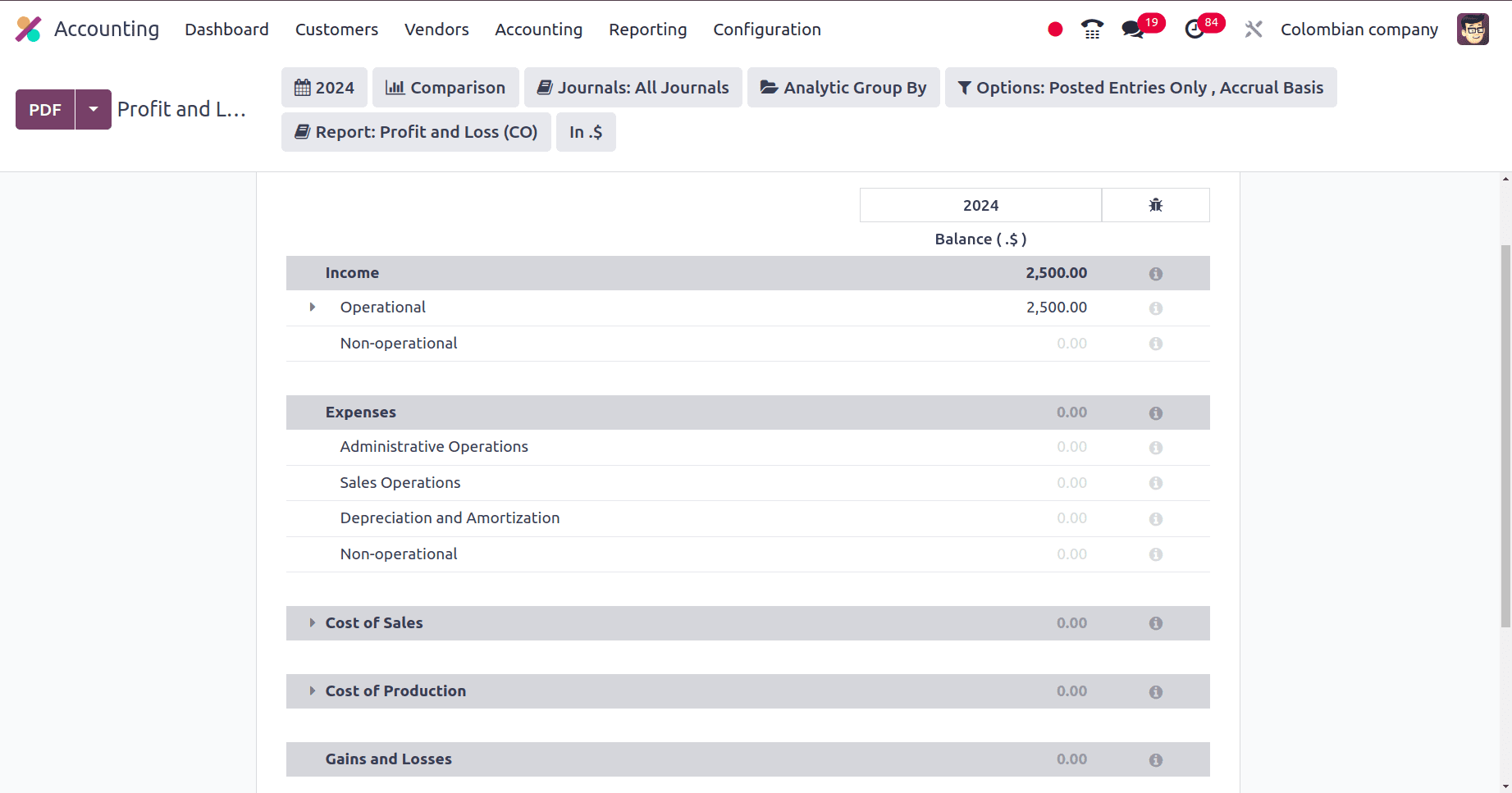
In this list, you can see the profit and loss report of the Colombian company. Income, Expenses, cost of sale, Cost of production, Gain and Loss, Income tax, and Net income are listed in the Profit and Loss report of a Colombian company. Operational income and non-operational income are included in the income and Administrative operation, sales operation, depreciation and amortization and non-operational are included in the Expenses.
Chart of Accounts serves as the basis for keeping track of all of your financial transactions. It basically serves as a list of all the accounts your Odoo accounting system uses to classify the financial activity of your company. First, click the configuration menu of the accounting application, and then the Chart of Accounts sub-menu. There you obtain a list of Chart of Accounts that Colombian businesses can use.
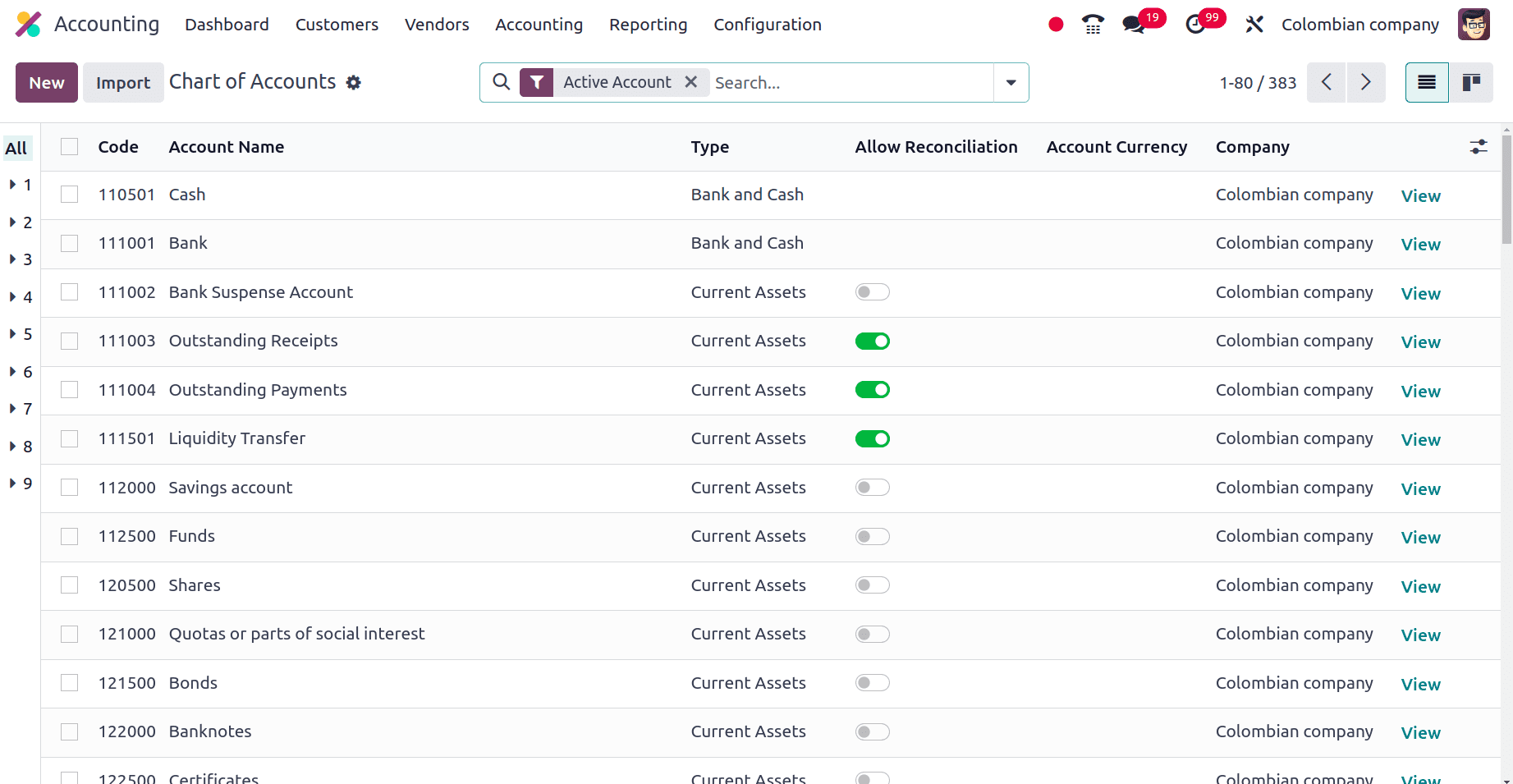
The above screenshot shows the accounts that are accessible to businesses in Colombia and the companies can use those different accounts for different purposes.
Under the Reporting menu of the accounting application, an extra section ‘Colombian Statements’ is added, and under this Colombian Statements section ‘Certificado de Retención en ICA’,’ Certificado de Retención en IVA’, and ‘Certificado de Retención en Fuente’ are added.
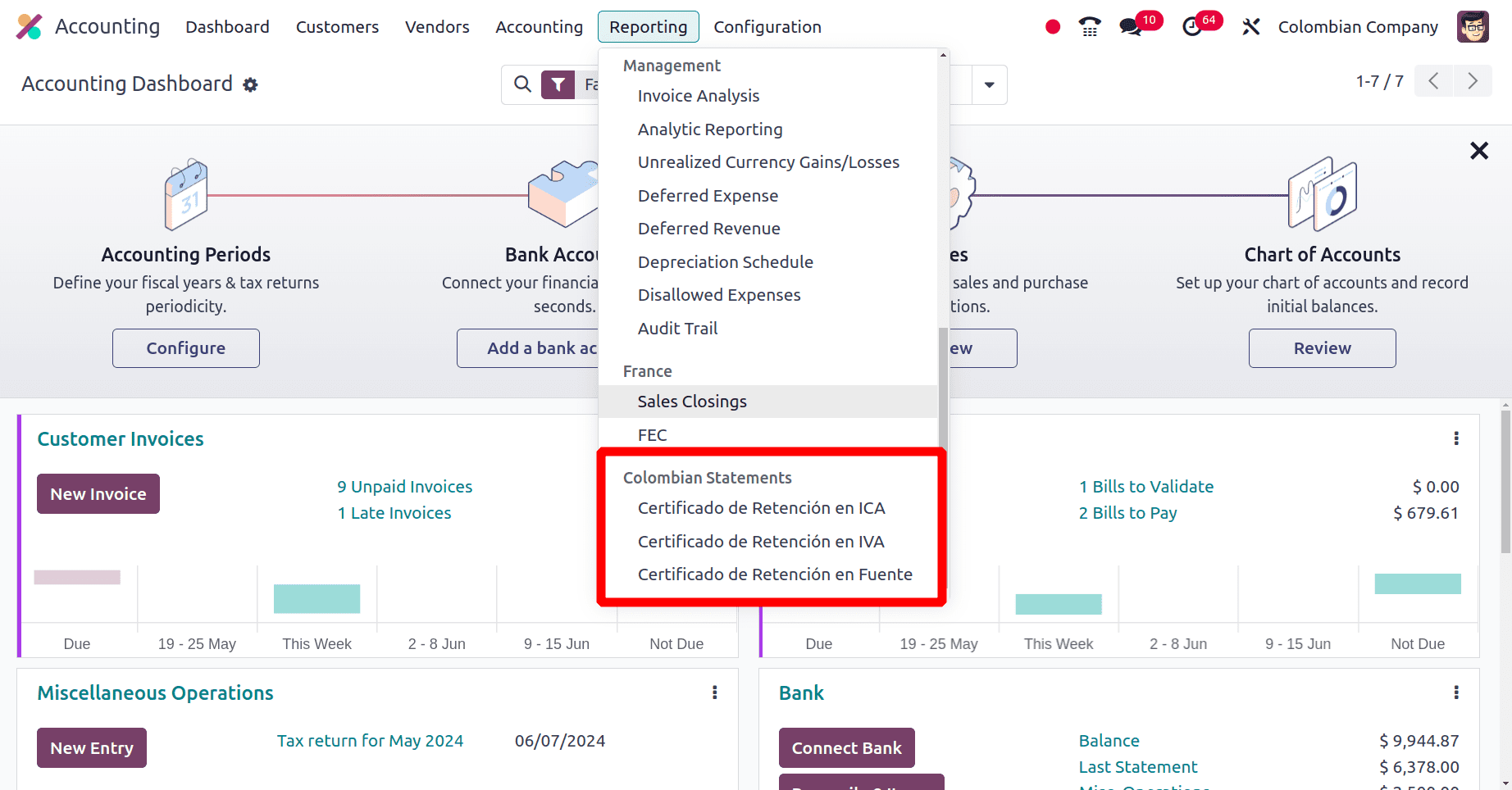
* Certificado de Retención en ICA: It is a certificate of withholding for the Colombian Industry and Commerce (ICA) tax that is obtained from vendors. It is provided to vendors as an official document informing them of the amount of ICA tax deducted from their payments.
* Certificado de Retención en IVA: It is an official record that attests to the quantity of Value Added Tax (VAT) deducted from suppliers. It details the VAT withheld on their transactions and acts as an official document for the seller and the company.
* Certificado de Retención en Fuente: it is a report created to detail the withholding taxes withheld from payments made to vendors, suppliers, or other organizations. Usually, income tax, value-added tax (IVA), or other applicable taxes are imposed on these deductions.
The localization feature of Odoo 17 for accounting procedures provides a comprehensive solution tailored to the unique requirements and laws of multiple locations. By integrating nation-specific regulations into Odoo 17, businesses may enhance reporting accuracy, boost compliance, and simplify financial operations. With localization, businesses can handle intricate tax systems, adhere to legal regulations, and gain greater financial performance information. In the end, Odoo 17's accounting localization ensures compliance with local financial regulations, promoting growth and longevity, and empowering enterprises to operate successfully in global markets.
To read more about An Overview of Accounting Localization for Australia in Odoo 17, refer to our blog An Overview of Accounting Localization for Australia in Odoo 17.